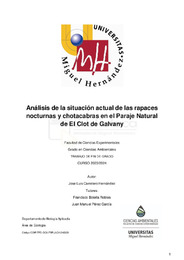Please use this identifier to cite or link to this item:
https://hdl.handle.net/11000/33291Full metadata record
| DC Field | Value | Language |
|---|---|---|
| dc.contributor.advisor | Botella Robles, Francisco | - |
| dc.contributor.advisor | Perez Garcia, Gerardo Juan Manuel | - |
| dc.contributor.author | Carretero Hernández, José Luis | - |
| dc.contributor.other | Departamentos de la UMH::Biología Aplicada | es_ES |
| dc.date.accessioned | 2024-09-25T11:42:18Z | - |
| dc.date.available | 2024-09-25T11:42:18Z | - |
| dc.date.created | 2024-06 | - |
| dc.identifier.uri | https://hdl.handle.net/11000/33291 | - |
| dc.description.abstract | Los humedales son ecosistemas donde existe una gran biodiversidad florística y faunística, esto los hace zonas que requieren una gestión eficaz, puesto que a pesar de contener tanta biodiversidad son áreas muy sensibles al cambio y fáciles de degradar por el ser humano. Las especies con hábitos nocturnos son unas de las menos estudiadas y que menos importancia a la hora de la gestión se les otorga, especies como el Mochuelo europeo (Athene noctua) o la Lechuza blanca (Tyto alba) están sufriendo una gran regresión en sus poblaciones debido en gran parte a la pérdida de su hábitat natural por la construcción de nuevas áreas urbanizadas. En el presente estudio se ha realizado un exhaustivo análisis sobre la situación y el estatus actual de las rapaces nocturnas y chotacabras de un humedal protegido como es El Clot de Galvany, comparando los datos obtenidos en el año 2024 con los que se obtuvieron en 2004 y 2014. Además, se ha tratado de relacionar el descenso de las parejas de distintas especies de avifauna nocturna con el cambio de los usos del suelo en la zona. El estudio se ha realizado con el propósito de reforzar el marco de gestión del Paraje Natural Municipal para que sea más efectivo en cuánto a especies con hábitos nocturnos se refiere. | es_ES |
| dc.description.abstract | Wetlands are ecosystems where there is a high wildlife diversity, this makes them areas that require effective management, since despite containing so much biodiversity they are areas very sensitive to change and easy to degrade by humans. Species with nocturnal habits are the least studied and the least important when it comes to management. Species such as the Little Owl (Athene noctua) or the Barn Owl (Tyto alba) are suffering a great regression in their populations due in large part to the loss of their natural habitat by the construction of new urban areas. In the present study, an exhaustive analysis of the current situation and status of nocturnal raptors and nightjars in a wetland such as El Clot de Galvany has been carried out, comparing the data obtained in the year 2024 with those obtained in 2004 and 2014. In addition, we have tried to relate the decrease in the number of pairs of different species of nocturnal birds with the change in land use in the area. The study has been carried out with the aim of strengthening the management framework of the Municipal Natural Park to make it more effective in terms of nocturnal species. | es_ES |
| dc.format | application/pdf | es_ES |
| dc.format.extent | 31 | es_ES |
| dc.language.iso | spa | es_ES |
| dc.publisher | Universidad Miguel Hernández de Elche | es_ES |
| dc.rights | info:eu-repo/semantics/openAccess | es_ES |
| dc.rights | Attribution-NonCommercial-NoDerivatives 4.0 Internacional | * |
| dc.rights.uri | http://creativecommons.org/licenses/by-nc-nd/4.0/ | * |
| dc.subject | humedales | es_ES |
| dc.subject | mochuelo europeo | es_ES |
| dc.subject | lechuza blanca | es_ES |
| dc.subject | chotacabras | es_ES |
| dc.subject | wetlands | es_ES |
| dc.subject | little owl | es_ES |
| dc.subject | barn owl | es_ES |
| dc.subject | nightjar | es_ES |
| dc.subject.other | CDU::5 - Ciencias puras y naturales::57 - Biología::574 - Ecología general y biodiversidad | es_ES |
| dc.title | Análisis de la situación actual de las rapaces nocturnas y chotacabras en el Paraje Natural de El Clot de Galvany | es_ES |
| dc.type | info:eu-repo/semantics/bachelorThesis | es_ES |

View/Open:
TFG-Carretero Hernández, José Luis.pdf
1,75 MB
Adobe PDF
Share:
.png)
